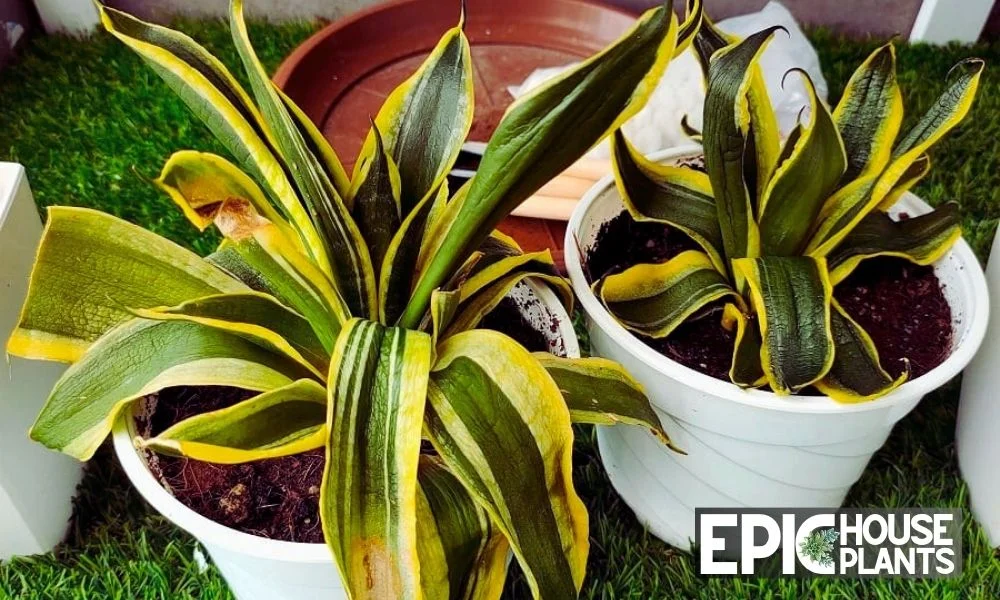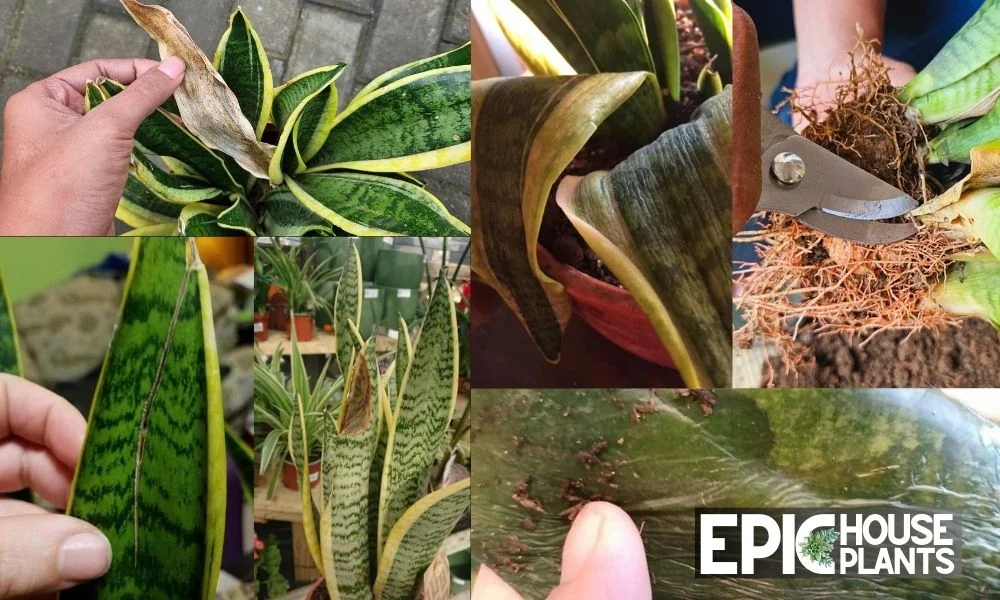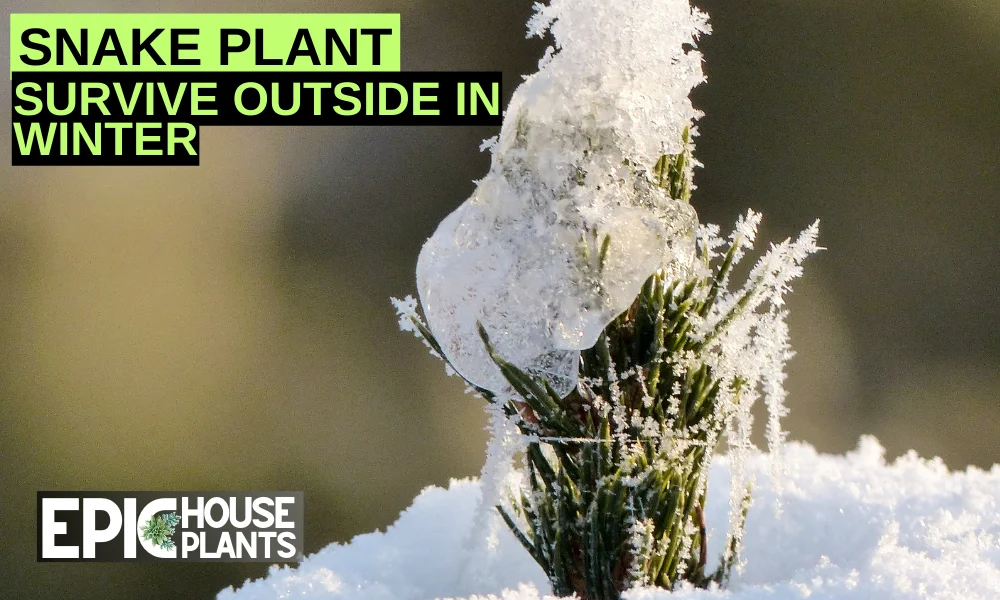As a houseplant enthusiast, nothing tugs at my heartstrings quite like a parched plant in distress. Today, we’re going to focus on a particularly hardy but oft-misunderstood one: the snake plant.
Let’s look at my experience dealing with an underwatered snake plant and the signs I’ve picked up along the way.

Recognizing Signs of an Underwatered Snake Plant
Spotting an underwatered snake plant isn’t always easy, especially if you’re new to plant parenthood. But trust me, once you know what to look for, it becomes almost second nature.
Leaves Falling Over or Drooping
An obvious sign is when your plant’s leaves start falling over or drooping. You see, water gives strength to those plant cells in the leaves, keeping them perky and upright. Without enough hydration, they can’t stand tall and will slowly start to wilt.
Curling Leaves Inward
Ever noticed your snake plant’s leaves curling inward? This is a sign of long-term thirst. The poor thing is probably using up all the water it stored in its leaves just to survive, leading to this sad curling effect.
💡Also Read: On a related note, overwatering can cause similar issues, but it’s a whole other ball game. You can read more about that here.
The Telltale Color Changes: Yellow and Brown

Color changes in your plant are like a visual SOS message, urging you to step in and take action.
Oldest Leaves Turning Yellow
Underwatering can lead to dehydration and nutrient deficiencies, which cause the oldest leaves to turn yellow. If this condition persists, these yellow leaves may even turn brown.
Brown Leaf Tips and Edges
What about those brown leaf tips and edges? This is another distress signal from your plant, asking for more water. The longer it goes without a drink, the more brown and crispy these leaves become. For more on this topic, you might want to check out this post.
The State of the Soil: Dry and Craving Moisture
Lastly, let’s not forget about the soil – it’s as important as the plant itself!
Dry Soil
Dry soil from top to bottom is a big sign that your snake plant is underwatered. To check this, you can use an electronic moisture meter or a probe to measure the soil’s dampness near the roots.
If it’s bone dry, your plant is likely begging for a good soak. For tips on choosing the best soil for your snake plant, here’s an article I recommend.
Remember, your snake plant depends on you for its water needs. If you notice any of these signs, take immediate steps to rectify the situation. With a bit of care and attention, you’ll have your green friend back to its vibrant self in no time!
How to Help Your Underwatered Snake Plant Thrive

As a fervent houseplant lover, one of my favorites has always been the resilient yet often misunderstood snake plant. This plant can take a hit, but like any other, it has its limits. Today, let’s tackle an issue these sturdy plants can sometimes face – underwatering.
Factors Influencing Watering Frequency
In my experience, watering a snake plant is not a one-size-fits-all situation. It’s influenced by several conditions which need to be considered.
Lighting Conditions
For instance, an outdoor snake plant needs more water than its indoor cousin due to more exposure to sun and wind, which cause it to dry out faster.
Types of Soil
Next up is the soil. Compact soil needs more frequent watering because it struggles to retain water as well as a lighter, well-draining mix.
Humidity Level
A lower humidity level can also lead to an increased watering frequency. Why? Lower humidity speeds up transpiration, causing your snake plant to lose water faster.
Temperature
Last but not least, the temperature plays a big role. In summer, when the mercury soars, your snake plant will need more frequent drinks. But come winter, you can reduce the watering.
Saving Your Underwatered Snake Plant: Spot the Difference

As we dive deeper into the world of underwatered snake plants, it’s crucial to know the differences between overwatered and underwatered ones. The signs can be similar but knowing these subtle differences can help save your plant.
Leaves
Underwatered snake plants have leaves that curl inward, looking shriveled and dry. On the other hand, overwatered plants have mushy, soggy leaves, with no curling.
Drooping Leaves
In the case of drooping leaves, an underwatered plant starts to yellow and droop from the lower leaves first. But an overwatered plant exhibits yellowing and drooping of all leaves.
Roots
The roots are also telling. Underwatered plants have black and dry root hair due to lack of water, whereas overwatered ones suffer from root rot caused by fungus and bacteria.
Soil
Lastly, the soil of an underwatered plant is dry from bottom to top, while in overwatered plants, the bottom soil stays wet.
💡Also Read: Want the secret recipe for the perfect snake plant soil? Follow this guide on 7 Best Soil for Snake Plant + Make Your Own Soil Potting Mix.
Here’s a simplified table to help you quickly distinguish between an underwatered and an overwatered snake plant:
| Signs | Underwatered Snake Plant | Overwatered Snake Plant |
|---|---|---|
| Leaves | Inward curling, shrivel and dry | Mushy and soggy, no sign of curling |
| Drooping Leaves | Yellow and drooping start from lower leaves | Yellow and dropping of all leaves |
| Roots | Black and dry root hair due to lack of water | Rotten roots caused by fungus and bacteria |
| Soil | Dry soil from bottom to the top | Bottom soil stays wet |
Author Note:
Remember, it’s all about observation and quick action. If you can spot these signs early, you’ll be better equipped to save your snake plant. Happy gardening!
Watering Your Snake Plant Well: The Solution

Alright, let’s talk about the rescue plan for your underwatered snake plant!
Soak It Well
If your snake plant has gone dry for too long, soak it well. Just ensure the excess water flows from the drainage holes to avoid waterlogging the roots.
Top Watering vs. Bottom Watering
Finally, pick a watering method that suits you best. You can either water from the top or opt for bottom watering. Both methods work well as long as you ensure that your snake plant is well-hydrated but not sitting in water. Want to learn more about watering your snake plant? Check out this post.
Preventing Underwatering in the Future
Shield from Intense Solar Exposure:
Intense solar exposure can cause dehydration in plants by accelerating evaporation, leading to underwatering. One preventative measure is to provide appropriate shielding from the harsh sunlight, especially during peak hours.
You could utilize shades or blinds if your plant is indoors, or position outdoor plants in spots with partial shade. Furthermore, understanding each plant’s specific sunlight needs is crucial as some may thrive in less sunlight while others require more.
Distance from HVAC Systems:
Heating, Ventilation, and Air Conditioning (HVAC) systems can cause the ambient air to dry out, leading to rapid soil dehydration. Plants near these systems often suffer from underwatering.
Therefore, relocating your plants away from HVAC vents or other sources of artificial heat or cool air can help maintain soil moisture for longer periods. Using a humidifier near your plant can also help in maintaining an appropriate humidity level in such circumstances.
Repotting into a Larger Container:
Sometimes, plants can become root-bound or outgrow their pots, causing the water to drain too quickly and leading to underwatering. Repotting snake plant into a larger container can help in maintaining soil moisture.
The additional soil in a larger pot retains more water, providing a greater reserve for the plant to draw upon. However, it’s important to do it cautiously as over-potting can lead to waterlogging, which can harm the plant.
Set a Watering Schedule:
Plants thrive on consistency and maintaining a regular watering schedule helps to prevent underwatering. Watering frequency depends on the plant species, its size, pot size, and the environment it is in.
By adhering to a watering timetable, you ensure that your plant gets the necessary hydration at regular intervals, thereby avoiding drying out of the soil. You can also tailor the watering schedule based on seasonal variations and specific needs of your plant.
Use a Plant Thirst Detector (Moisture Meter):
A moisture meter or monitor is a handy tool that provides accurate data about the soil’s moisture content. This can prevent both overwatering and underwatering, as it allows you to understand when your plant truly needs water.
Just insert the meter into the soil and it will tell you if your plant requires watering. It is particularly useful for those new to plant care or for those looking after a variety of plants with different water needs.
Choosing Correct Soil Type:
Different plants have different soil requirements. Some plants prefer sandy soil which drains quickly, while others may thrive in soil that retains water for longer periods.
By understanding your plant’s needs and choosing the correct type of soil, you can prevent underwatering. Additionally, the use of soil amendments like compost or mulch can help retain moisture in the soil.
Author

Pudji Haryanto
Pudji Haryanto is a writer and urban farmer with a passion for cultivating plants. He has over 15 years of experience in agriculture and currently manages a 65,000 square foot rice-field and yard filled with various plants, including vegetables, spices, flowers, and garden plants.


